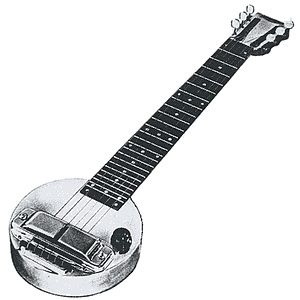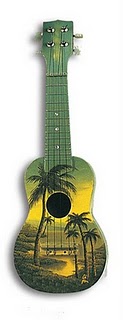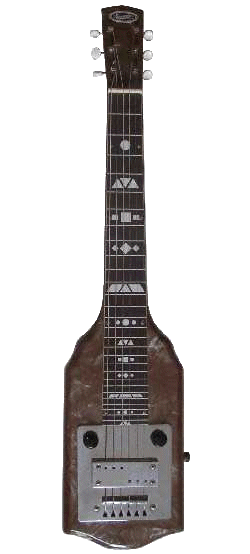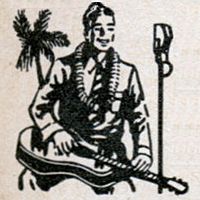An Illusion to the Ears
An Illusion To The Ears
 Technique is what requires years
to master. One can learn their scales and chord progressions in a relatively
short time, but to master the techniques that distinguish the great steel
guitar players requires patience, persistence, hard work, and time. I used
to wonder how Lloyd Green (my favorite E9th pedal steel player) did certain
things on the steel guitar. At first I sincerely thought he had an extra
knee lever, or a secret trick, or something special on his guitar setup that
I didn't have.
Technique is what requires years
to master. One can learn their scales and chord progressions in a relatively
short time, but to master the techniques that distinguish the great steel
guitar players requires patience, persistence, hard work, and time. I used
to wonder how Lloyd Green (my favorite E9th pedal steel player) did certain
things on the steel guitar. At first I sincerely thought he had an extra
knee lever, or a secret trick, or something special on his guitar setup that
I didn't have.
Over the years I came to realize through hard work and practice that everything Lloyd was playing was the same exact pedals and chords I had been playing for years; he just had learned how to master certain techniques that enabled him to play uniquely different than most players.
In fact, it is quite amazing how Lloyd uses the same pedals on a very simple steel guitar setup to achieve majestic sounding music on his guitar. I learned from Lloyd that steel guitar is often an illusion to the ears. That is to say, you wouldn't think that what you are hearing is produced by what is actually being played on the guitar. Jerry Byrd also spoke of this phenomena on the steel guitar; where a person hears higher pitch notes, but the steel player is actually playing those notes on the first few frets of the guitar. This is due to the nature of the steel guitar, where you have high notes on strings 1,2 and 3, et cetera. You can move the steel guitar playing bar merely 3 frets, but in the listener's mind, it sounds like the bar moved many frets higher. It's an illusion to the ears.
This is an important topic to grasp because it's important that the learning steel guitarist realize that many of the sounds you'll hear and desire to play are not as difficult as they may seem. Many of the things that I used to have difficulty figuring out on Lloyd Green's playing were solved when I learned to start using strings 6 and 2 on the E9th pedal steel. Lloyd has pioneered a whole new style of playing just by using strings 6 and 2, and also strings 5 and 1. And also by making much more extensive use of pedals B and C together. I am amazed at some of the things they Lloyd Green has discovered and played in the latter half of his music career. These techniques are best showcased I think on his album, REVISITED. His timing is impeccable, and his bar execution is flawless.
 I was studying Jerry Byrd's
rendition of Beyond the Reef. The harmonic are awesome. It seemed almost
impossible until I worked at it for awhile. The harmonics and bar slant must
be right on (i.e., accurate) to sound right. I think a lot of the great
musicianship that we hear from the older legends had to do with the lack of
technology back then. You can make mistakes today and fix it with computer
software, but you couldn't do that in the old days. Back then your amp went
straight into a microphone. What you played went onto the record, mistakes
and all.
I was studying Jerry Byrd's
rendition of Beyond the Reef. The harmonic are awesome. It seemed almost
impossible until I worked at it for awhile. The harmonics and bar slant must
be right on (i.e., accurate) to sound right. I think a lot of the great
musicianship that we hear from the older legends had to do with the lack of
technology back then. You can make mistakes today and fix it with computer
software, but you couldn't do that in the old days. Back then your amp went
straight into a microphone. What you played went onto the record, mistakes
and all.
 Thus, musicians back in the 1930's
through the 1970's had to be precise. They learned to play everything
note-for-note exact, and that was their mindset when practicing. In sharp
contrast, musicians today know that they can make mistakes, mess up, and fix
it using computer software. So I think younger musicians tend to be more
sloppy in their playing. I'd recommend that you strive to play every note
deliberately. Know what you're playing. Try not to make mistakes. Play slow,
as slow as you need to, in order not to make any mistakes. Then, as you
learn the song, play it faster, until eventually you can play it up to
speed.
Thus, musicians back in the 1930's
through the 1970's had to be precise. They learned to play everything
note-for-note exact, and that was their mindset when practicing. In sharp
contrast, musicians today know that they can make mistakes, mess up, and fix
it using computer software. So I think younger musicians tend to be more
sloppy in their playing. I'd recommend that you strive to play every note
deliberately. Know what you're playing. Try not to make mistakes. Play slow,
as slow as you need to, in order not to make any mistakes. Then, as you
learn the song, play it faster, until eventually you can play it up to
speed.
Remember, making music is not magic, although it is magical in what it does to the heart. Music is science, timing, skill, and creativity all wrapped into one. Music is the expression of the soul. When I play, I notice all my mistakes, but have learned over the years that most people don't hear the mistakes. Most people aren't scrutinizing every note that we play as we do. If you make a mistake while playing in public, keep playing like nothing happened. Don't make a face or frown, just keep playing like it was intended. Unless it's a whopper of a mistake, then smile. Remember to C# or you'll Bb.
Often what you hear will sound much more difficult to play than it really is. Don't develop the mindset that things are hard, because then you'll frighten yourself away from tackling more challenging things, like harmonics and faster songs. I do recommend that you choose one tuning to start and stick with it until you become proficient, and then journey out into other horizons. I'd recommend the C6th tuning of course, because it offers the most chords and playability. The C6th is becoming increasingly popular with the GeorgeBoards courses and websites like this, et cetera. It's ok to try other tunings, I'm just saying that I would focus on learning my C6th scales, chord progressions, and songs, until you can play it by ear.
I'd learn the B11th second, because it is a fantastic Hawaiian tuning. Just learn a half dozen songs on the B11th and memorize them. SAND is great.
~By David J. Stewart
Take someone to the islands today with your music!

Kindly, if all you have is music, you have nothing! You need Jesus Christ as your personal Savior to truly be prosperous in life. You may be the poorest man in the world materialistically, but if you have received Jesus as the Christ, the Son of God; believing on His name to forgive your sins, then you are a rich soul indeed!


